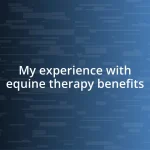Key takeaways:
- Healing from trauma is a unique, nonlinear journey that involves nurturing affected parts of ourselves, often supported by the presence of empathetic animals like horses.
- Horses possess an intuitive ability to sense and mirror human emotions, fostering deep emotional connections that aid in the healing process.
- Techniques used in horse-assisted therapy, such as groundwork and sensory engagement, can lead to profound realizations and emotional clarity, enhancing the overall therapeutic experience.

Understanding trauma and healing
Trauma is such a complex experience; it often lingers beneath the surface, subtly shaping our thoughts and reactions. I remember a time when I felt completely overwhelmed by memories, as if they were constantly playing in my mind like a broken record. Have you ever felt trapped in a moment that you wished you could just forget? For many, healing from trauma is not linear; it’s more like a winding path with unexpected twists and turns.
I’ve learned that healing isn’t just about addressing the traumatic event itself but also about nurturing the parts of ourselves that have been affected. There were days when I would sit beside my horse and just cry, feeling the comfort of her presence soothe my racing thoughts. Isn’t it fascinating how animals can sense our emotions? Their unspoken support can open up pathways to healing that we didn’t even know existed.
Understanding trauma also means recognizing that everyone’s journey is unique. I often find myself reflecting on my own experiences and how different they are from others. Why is it that some days I feel empowered, while other days I feel burdened? It’s crucial to acknowledge these fluctuations and allow ourselves the grace to heal at our own pace.

How horses sense emotions
Horses are incredibly intuitive creatures. I’ve often marveled at how they seem to pick up on the emotions swirling around me, even before I consciously recognize them myself. They don’t just react; they absorb the energy and emotions of those around them, making them natural mirrors to our feelings. It’s as if they have a sixth sense, one that helps them interpret what humans might struggle to express verbally.
- Horses have a keen ability to read body language, which often communicates more than words ever could.
- They can sense changes in heart rate, breathing, and even chemical signals in sweat and breath.
- This sensitivity allows them to respond to anxiety, fear, or calmness, creating a profound connection with their handlers.
- I once brought a friend to visit my horse during a stressful period in her life. Even without us saying much, my horse approached her gently, nuzzling her arm as if to say, “I see you.”
Each interaction reinforces my belief that horses offer a type of emotional support that is both instinctive and profound. I can’t help but feel that their presence acts as a balm, helping to uncover and soothe the hidden hurts inside us.

Therapeutic benefits of equine interaction
The therapeutic benefits of equine interaction are profound and multifaceted. Just spending time with a horse can be a grounding experience. I remember one afternoon standing in the stable, silently brushing my mare’s coat. With each stroke, I felt my body relax as the worries of the day faded away. It’s remarkable how these moments can offer respite from emotional turmoil, fostering a sense of calm that can be hard to find elsewhere.
Connecting with horses not only nurtures emotional healing but also promotes physical well-being. The act of grooming, riding, or even just walking alongside a horse can serve as a gentle yet effective way to move our bodies. The mindfulness required—being present in the moment with these majestic animals—can have a transformative effect. Have you ever noticed how focusing on a horse’s rhythmic movements helps quiet a racing mind? For me, it’s almost meditative.
Moreover, equine therapy has been shown to improve social skills and emotional regulation. I’ve seen firsthand how group sessions with horses can foster a sense of community and support. During one session, I watched as participants shared stories while grooming horses together. The laughter and camaraderie that developed were heartwarming, showing just how powerful shared experiences with horses can be. For many, this creates social bonds that extend far beyond the barn.
| Benefit | Description |
|---|---|
| Emotional Healing | Equine interaction provides a calming presence, helping to soothe emotions and promote relaxation. |
| Physical Activity | Grooming and riding encourages movement, aiding both physical and mental wellness. |
| Social Skills | Group therapy with horses fosters community, enhancing communication and support. |

Techniques for horse-assisted therapy
One technique I find particularly effective in horse-assisted therapy is the practice of groundwork. During my sessions, I often start by simply walking alongside a horse, establishing that vital connection without the distraction of riding. It amazes me how this simple act can lead to profound realizations. Have you ever experienced a moment where a horse seems to draw you into its world, encouraging you to be fully present? That feeling of connection is like an unspoken dialogue that nurtures trust.
Another valuable technique is the use of guided imagery while interacting with horses. I remember a session where the therapist guided me to visualize my emotions as landscapes while standing with my horse. Closing my eyes, I pictured a stormy sea representing my anxiety. When I opened my eyes, my horse was calmly grazing beside me. That visual transformation was powerful! It helped me understand that while storms may arise, I could seek calm in just being with my horse.
Finally, incorporating sensory engagement is a game changer. Engaging with the horse’s coat, feeling its warmth, and listening to its rhythmic breathing really amplifies the therapeutic experience. During one particularly tough week, I took time to sit with my horse and simply breathe together, absorbing the grounding energy of our surroundings. It felt almost like a shared meditation. When was the last time you relished a moment of stillness with an animal? Those moments not only anchor us but also remind us of the simplicity of connection amidst chaos.

Personal stories of healing journeys
Reflecting on my healing journey with horses, I can’t help but remember one particular moment during a therapy session. As I crouched down to tie my horse’s bandana, I felt an overwhelming wave of emotion wash over me. It struck me how, in that simple act of care, I found myself releasing layers of grief I didn’t even know I was holding. Have you ever had moments where a mundane task suddenly provides clarity on your emotional state? It was as if those little actions bridged my heart to the present, allowing space for healing.
Engaging in equine therapy has also brought about surprising connections. I participate in a group session that focuses on sharing our stories while working with horses. One day, I opened up about my struggles with anxiety, and as I did, my horse nuzzled against my shoulder, as if providing comfort. In that moment, I realized the power of vulnerability — not just with my human companions but also with these incredible animals. Can you imagine sharing your deepest fears in a space filled with compassion and understanding? It’s profoundly liberating.
Moreover, I often find that nature plays a significant role in my healing. One evening, I stood in the field as the sun began to set, casting a golden hue over everything. My horse grazed nearby, and I found myself reflecting on how far I’ve come. In those quiet moments, I learned to appreciate the beauty of stillness, realizing that healing isn’t always a linear journey. Have you ever taken a pause to acknowledge your progress? It’s a gentle reminder that every small step counts.














